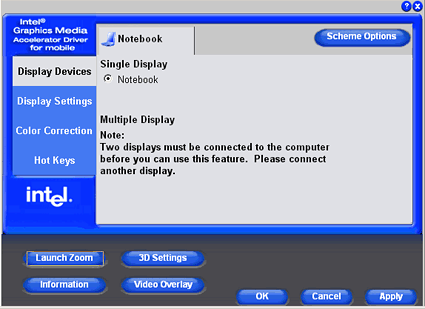HP DV1000T Is Happy In The Office Or The Den
MobilityGuru takes its first look at a mobile computer with Intel's GMA 950 integrated graphics processor, HP's Core Duo DV1000T laptop. How does the GMA 950 compare with the older GMA 900 technology? And, what's the DV1000T like?
Intel's 945PM/GM Chipset Technology
Before we move on to testing the HP DV1000T, I need to introduce you to Intel's new 945PM/GM chipset technology. This will help you better appreciate some of the tests that are to come. Again let me note that we will be publishing a more detailed look at the 945GM chipset soon.
The two key aspects of Intel's Centrino Duo Mobile technology are Core Duo mobile CPUs and the 945PM Express and 945GM Express chipsets. The 945PM is used in mobile computers with discrete graphics processors - graphics processors that are external to the 945 chipset - and provides all chipset functionality but the graphics functionality provided by the discrete graphics processor itself. The 945GM, which also supports discrete processors but is not as cost effective as the 945PM if a discrete processor is used, includes an integrated graphics processor, the Intel Graphics Media Accelerator 950 (GMA 950). Aside from the graphics differences, the two chips are identical.
The following table shows the characteristics of the two chips. It is based on Intel specifications data.
| Header Cell - Column 0 | Mobile Intel 945GM Express Chipset | Mobile Intel 945PM Express Chipset |
|---|---|---|
| Processors Supported | Intel Core Duo processor Intel Core Duo processor Low Voltage (LV) Intel Core Duo processor Ultra Low Voltage (ULV) Intel Core Solo processor Intel Core Solo processor Ultra Low Voltage (ULV) Intel Celeron M processor Intel Celeron M processor Ultra Low Voltage (ULV) | Intel Core Duo processor Intel Core Duo processor Low Voltage (LV) Intel Core Duo processor Ultra Low Voltage (ULV) Intel Core Solo processor Intel Core Solo processor Ultra Low Voltage (ULV) Intel Celeron M processor Intel Celeron M processor Ultra Low Voltage (ULV) |
| FSB Speed | 667 MHz 533 MHz | 667 MHz 533 MHz |
| #SO-DIMMs/Max Memory | 2 SO-DIMMs / up to 4 GB Max System Memory @ 533 MHz (use with 667 MHz memory not validated) | 2 SO-DIMMs / up to 4 GB Max System Memory @ 533 MHz (use with 667 MHz memory not validated) |
| Memory Type | DDR2 667 MHz DDR2 533 MHz | DDR2 667 MHz DDR2 533 MHz |
| Memory Channels | Dual/Single Channel | Dual/Single Channel |
| ECC Parity | No | No |
| Integrated Graphics | Intel GMA 950 | N/A |
| Discrete Graphics | PCI Express x16 | PCI Express x16 |
| Integrated TV Out | Yes | N/A |
| Max Panel Display Resolution | LVDS: Up to UXGA (1600x1200) | N/A |
| Dual Display Options | Concurrent/Simultaneous | Concurrent/Simultaneous |
| Power Management | Enhanced Intel SpeedStep Technology, Deeper Sleep | Enhanced Intel SpeedStep Technology, Deeper Sleep |
| Intel Display Power Savings Technology | Yes | N/A |
| PCI Masters | 7 | 7 |
| IDE / ATA | ATA 100 (1 Ch.) SATA 150 (2 Ports) | ATA 100 (1 Ch.) SATA 150 (2 Ports) |
| USB | 8 Ports USB 2.0 | 8 Ports USB 2.0 |
| Integrated LAN MAC (w/10/100 Ethernet or HTNA) | Yes | Yes |
| PCI Express I/O Ports | 4X1 PCI Express Ports | 4X1 PCI Express Ports |
| Audio Circuitry | Intel High Definition Audio 24bit 192KHz, AC'97 2.3 Audio | Intel High Definition Audio 24bit 192KHz, AC'97 2.3 Audio |
| Supported ICH | 82801 GBM / 82801GHM | 82801 GBM / 82801GHM |
The HP DV1000T has the 945GM Express chipset and borrows up to 128 MB of system memory for graphics processing. The N6410, with a separate ATI Mobility Radeon X1400 graphics processor (128 MB of dedicated memory and the ability to use up to 128 MB of shared systen memory) uses the 945PM Express chipset. Both graphics processors can do 2D and 3D graphics. As you will see the ATI processor is the better performer of the two.

This is the interface used to modify the characteristics of the Intel GMA 950 graphics processor.
Before we leave our discussion of the 945GM/PM chipset, I need to call your attention to one of the rows in the above table, the one labeled "#SO-DIMMS/Max Memory." Check out the phrase in each column "(use with 667 MHz memory not validated)." Say what? Well at least one reason for the caveat has to do with system memory clock specs. It turns out that system memory clocks in some 945GM/PM based systems don't or at least at one time didn't meet DDR2 667 MHz DRAM device jitter requirements. This can cause problems with DDR2 667 MHz memory timing, if the memory doesn't meet all of the other requirements for DDR2 DRAM from Intel and JEDEC, the semiconductor engineering standardization body of the Electronic Industries Alliance (EIA). Intel claims that no functional memory failures have been observed.
Sign up to get the BEST of Tom's Guide direct to your inbox.
Get instant access to breaking news, the hottest reviews, great deals and helpful tips.
Current page: Intel's 945PM/GM Chipset Technology
Prev Page Using The HP Pavilion DV1000T: The Display Next Page Testing: Methods And BenchmarksTom's Guide upgrades your life by helping you decide what products to buy, finding the best deals and showing you how to get the most out of them and solving problems as they arise. Tom's Guide is here to help you accomplish your goals, find great products without the hassle, get the best deals, discover things others don’t want you to know and save time when problems arise. Visit the About Tom's Guide page for more information and to find out how we test products.
